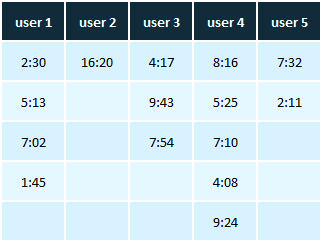How and why to count the time spent by users in the game?
The metric that reflects the time spent by the user in the product is called total daily play time. What to do with it, – says devtodev analyst Vera Karpova in our series of materials “Performance indicators of games”.
The publication is published as part of a series of materials about game metrics from App2Top.ru and devtodev. Articles are divided by seasons, each of which is dedicated to a specific topic. The second season is called “Users”. In it, we talk about those business metrics that reflect the effectiveness of the application in terms of working with the audience.

Vera Karpova
Almost always, the developer is interested in the user using his product as often as possible, for longer and more.
After all, the more time he spends in it, the more likely it is that he will pay or at least become interested and loyal to the product.
The metric that just reflects how much time a user spends in the product is total daily play time. It is calculated as follows:
Total daily play time = total sessions length / active users
The total duration of all sessions per day should be divided by the number of active users on that day (DAU).
As a result, we will find out how much time a user spends in the application on average per day.
This metric is similar to the average session length. They differ in the denominator: for average session length is the number of sessions, and for total daily play time is the number of users.
Let’s compare these two metrics with an example. Let’s say we have information about five users and the duration of their sessions (in minutes).
Let’s calculate both metrics based on this data:
- the total duration of all sessions is 1:38:50
- number of sessions – 15
- number of users – 5
- average session length – 06:35
- the average time in the game is 19:46
Despite the fact that the totals of these two metrics are quite different, based on our experience, the values themselves depend on the same factors, such as the genre of the game, which affect the nature of its use.
For example, in MOBA, the time spent in the game and the average session length will probably be longer than in a minimalistic project.
In addition to calculating the time spent in the product, you can impose on it various actions performed by the user to find out:
- how long does it take a player to complete N levels;
- how much time did he spend on completing this or that level;
- after how many minutes/hours spent in the product, the user made a purchase;
- how many hours or minutes pass between the first and second purchases;
- how many hours did the user spend in the app before leaving;
- how many hours did it take him to solve the puzzle;
- and any other questions that will allow you to better understand the user’s behavior in the game.
This is how a user’s day in a product might look like:

If we considered metrics in the traditional way, then these would be:
- 3 sessions;
- 1 purchase;
- 3 level up;
and all this in one day.
Counting only the game time allows you to more accurately describe the user’s behavior:
- 10.5 hours a day in the game;
- passing the 1st level after 4.5 hours in the game;
- passing the 2nd level after 8 hours in the game;
- passing the 3rd level after 9 hours in the game;
- purchase after 7 hours in the game.
How can this indicator be used?
Knowing how much time the user spends in the product every day, and what he manages to do during this time, you can plan marketing activities differently – tie them not to the day, but to the time spent in the game.
And after following the user for a long period, until the moment when he stops appearing in the application, it will be possible to say that he “lived” in the product, for example, not 50 days, but 180 hours.
Like other behavioral metrics related to sessions, total daily play time does not directly affect revenue, and depends primarily on the genre and features of the application. Nevertheless, it is still worth keeping an eye on it, because if for some reason users start spending less time in the application, this may affect other, more important, product metrics.
- Game performance indicators: average session durationGame Performance Indicators: Social LTV
- Performance indicators of games: downloads
- Game performance indicators: Active users (DAU/WAU/MAU)
- Game performance indicators: k-factor (virality)
- Game performance indicators: loyalty
- The first season of “Performance Indicators of games” has ended

